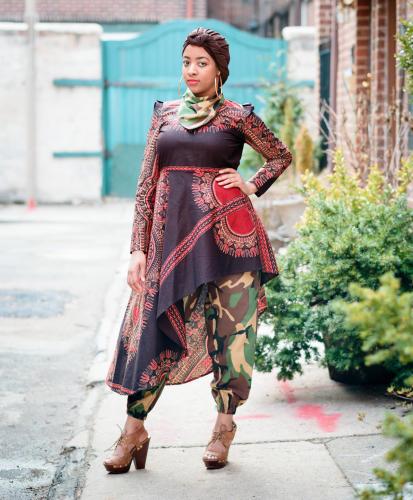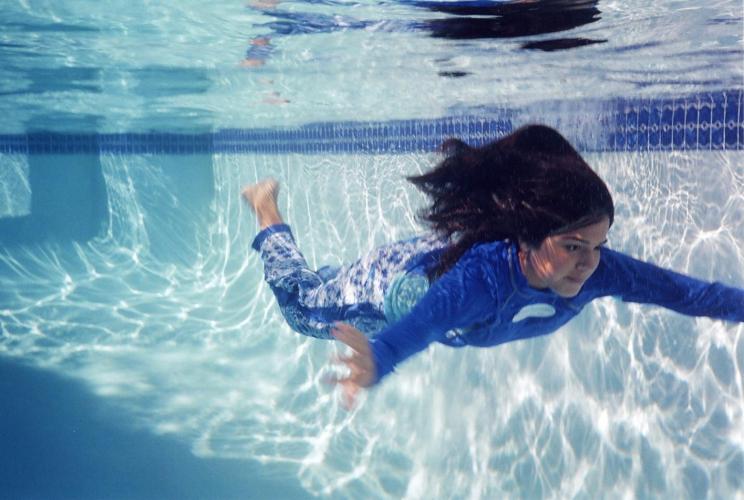
Ensemble by Naima Muhammad (born 1973, United States) for House of Coqueta (est. 2010, United States); Ensemble (tunic, pants, headwrap, and neck scarf), Yar Hawwa Collection; 2017; Printed cotton (tunic), cotton and polyester blend (pants).
Modest fashion is one of the fastest-growing parts of the global fashion industry. Contemporary Muslim Fashions, organized by the Fine Arts Museums of San Francisco and presented at our Cooper Hewitt, Smithsonian Design Museum, shares the work of designers, entrepreneurs, journalists, influencers, and others who have drawn international attention to the vitality of the Muslim modest style community.
Many Muslim people dress modestly as an expression of their faith and culture. Modest fashion describes clothes that cover the wearer's body to follow these cultural practices. This often includes a hijab or headscarf. What "modest" means varies for different Muslim men and women. Modest fashion also provides stylish options for non-Muslim women who prefer a more covered look.
There's a new generation of designer-businesswomen creating modest fashion. Here are four Muslim American women whose designs and work are featured in Contemporary Muslim Fashions.
1. Nzinga Knight
In 2014, Nzinga Knight became the first American Muslim hijab-wearing Project Runway contestant. She completed the show's design challenges while showcasing her own take on modest fashion.
Knight grew up in Brooklyn in a Caribbean family of seven women who embraced modest fashion. When she couldn't find clothing that fit her personal style and modest values, she decided to become a designer.
In this video, Knight discusses wearing a homemade gown at Eid, a celebration at the end of the month-long fast Ramadan. She says getting compliments on the gown she designed made her feel more connected to her community.
2. Naima Muhammad
Naima Muhammad founded the House of Coqueta, her modest fashion design label, in 2010. After a trip to visit her in-laws in Ghana, she started using colorful and bold African wax-print cloths in her designs. Her mother-in-law gave Muhammad her first piece of wax-print fabric—a popular design called Angelina. Muhammad combines the vivid patterns with high collars, long skirts, and wide-leg and parachute-style pants.

Ensemble by Naima Muhammad (born 1973, United States) for House of Coqueta (est. 2010, United States); Ensemble (tunic, pants, headwrap, and neck scarf), Yar Hawwa Collection; 2017; Printed cotton (tunic), cotton and polyester blend (pants).
3. Shereen Sabet
Californian Shereen Sabet founded Splashgear after she started dressing modestly in accordance with her faith. Sabet, a scientist and diver, needed new swimwear that allowed her to continue to pursue her passion while modestly dressed. Sabet's swimwear is inspired by surfer culture and her own dry suit. She creates mix-and-match pieces from the same water-repellent fabric used in men's board shorts. The fabric does not cling to the body or turn transparent when wet. Through Splashgear, Sabet encourages Muslim women to participate in water activities.

Shereen Sabet (born Egypt, 1970) for Splashgear, LLC (est. United States, 2005), Ensemble (shirt, pants, and swimhood); Hawaiian Colorway Collection, 2006, Polyester knit; Courtesy of Splashgear, LLC
4. Leah Vernon
Leah Vernon is a body positive activist, hijab-wearing model, and author of Unashamed: Musings of a Fat, Black Muslim. As a social media influencer, she helps increase the representation of Muslim American women in the fashion industry. She interprets Muslim modest style in non-traditional ways.
She said, "There is no [one] look to being a Muslim...There are Muslims [like me] who are kind of alternative, who also want to be accepted and not othered. I'm gonna always rock my turban and hijab. But the rest of it, it's up for interpretation."
In this video, Vernon shares how her blog, Beauty and the Muse, rebels against societal views of beauty.
To learn more about these women and other Muslim fashion designers, you can take the Contemporary Muslim Fashion virtual tour.